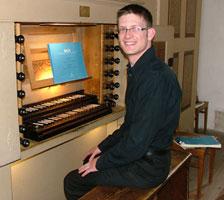
Bálint Karosi won first prize in the XVIth International Johann Sebastian Bach Competition held in Leipzig, Germany, in July. Karosi, 29, is the first American-based organist ever to win first prize, and with it a 10,000-euro award and the title of “Bachpreisträger” (“Bach Prizeholder”). The final round of competition was held at St. Thomas, Leipzig, on the historic Sauer organ and the new “Bach” organ. Karosi performed music by Bach as well as works by Liszt, Reger, and contemporary German composer Steffan Schleiermacher.
Born and raised in Hungary, Karosi currently lives in Boston, where he is music director at the First Lutheran Church. He came to America in 2003 to study at Oberlin Conservatory after earning degrees in clarinet, composition, and organ at Budapest’s Liszt Academy and the Geneva Conservatory. He holds the master’s degree and the artist diploma from Oberlin.


